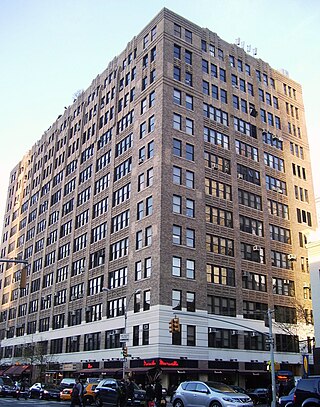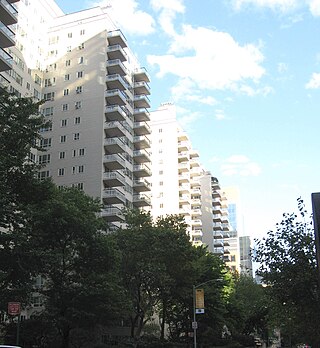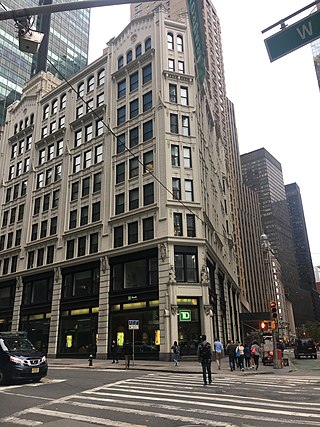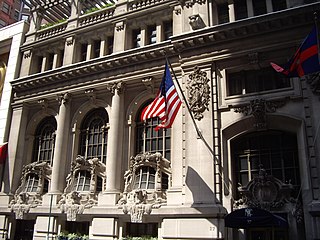The Chrysler Building is an Art Deco skyscraper on the East Side of Manhattan in New York City, at the intersection of 42nd Street and Lexington Avenue in Midtown Manhattan. At 1,046 ft (319 m), it is the tallest brick building in the world with a steel framework, and it was the world's tallest building for 11 months after its completion in 1930. As of 2019, the Chrysler is the 12th-tallest building in the city, tied with The New York Times Building.

The Port Authority Bus Terminal is a bus terminal located in Manhattan in New York City. It is the busiest bus terminal in the world by volume of traffic, serving about 8,000 buses and 225,000 people on an average weekday and more than 65 million people a year.

Tudor City is an apartment complex on the East Side of Manhattan in New York City, bordering the Turtle Bay and Murray Hill neighborhoods. It lies on a low cliff east of Second Avenue, between 40th and 43rd Streets, and overlooks First Avenue to the east. Designed and developed by the Fred F. French Company, the complex is named for its Tudor Revival architecture. Construction commenced in 1926, making it one of the first residential skyscraper complexes in the world. Tudor City was also one of the first and largest examples of a planned middle-class residential community in New York City. The complex is a New York City designated landmark district and is listed on the National Register of Historic Places.

The West Side Elevated Highway was an elevated section of New York State Route 9A running along the Hudson River in the New York City borough of Manhattan to the tip of the island. It was an elevated highway, one of the first urban freeways in the world, and served as a prototype for urban freeways elsewhere, including Boston's Central Artery.

The Royalton Hotel is a hotel at 44 West 44th Street in Midtown Manhattan, New York City, United States. The hotel, opened in 1898, was designed by architecture firm Rossiter & Wright and developed by civil engineer Edward G. Bailey. The 13-story building is made of brick, stone, terracotta, and iron. The hotel's lobby, which connects 43rd and 44th Streets, contains a bar and restaurant. The upper stories originally featured 90 apartments, but these were replaced with 205 guestrooms when Philippe Starck and Gruzen Samton Steinglass Architects converted the Royalton to a boutique hotel in the 1980s.

The Film Center Building, also known as 630 Ninth Avenue, is a 13-story office building on the east side of Ninth Avenue between 44th and 45th Streets in the Hell's Kitchen neighborhood of Manhattan in New York City. Built in 1928–1929, the structure has historically catered to businesses involved in film, theater, television and music and audio production. The building was designed in the Art Deco style, with Ely Jacques Kahn as the architect of record. The lobby's interior is a New York City landmark, and the building is on the National Register of Historic Places.

The Hotel Carter was a hotel at 250 West 43rd Street, near Times Square, in the Midtown Manhattan neighborhood of New York City. Opened in June 1930 as the Dixie Hotel, the 25-story structure originally extended from 43rd Street to 42nd Street, although the wing abutting 42nd Street has since been demolished. The hotel originally contained a bus terminal at its ground level, which was closed in 1957, as well as a bar and restaurant immediately above it. The upper stories originally contained 1,000 rooms but were later downsized to 700 rooms.

229 West 43rd Street is an 18-story office building in the Theater District of Midtown Manhattan in New York City. Opened in 1913 and expanded in three stages, it was the headquarters of The New York Times newspaper until 2007. The original building by Mortimer J. Fox of Buchman & Fox, as well as a 1920s addition by Ludlow & Peabody and a 1930s addition by Albert Kahn, are on 43rd Street. Shreve, Lamb & Harmon designed a wing on 44th Street in the 1940s. Columbia Property Trust owns most of the structure as an office building while Kushner Companies owns the lowest four floors as a retail and entertainment complex.

Shubert Alley is a pedestrian alley in the Theater District of Midtown Manhattan in New York City. The alley, a privately owned public space, connects 44th and 45th Streets and covers about 6,400 square feet (590 m2). It runs through the middle of a city block, parallel to Eighth Avenue to the west and Broadway to the east. The western half of the alley abuts the Shubert and Booth theaters, while the eastern half is adjacent to One Astor Plaza. Because it is near several major theaters, the alley has been considered the geographical center of Broadway theatre.

1501 Broadway, also known as the Paramount Building, is a 33-story office building on Times Square between West 43rd and 44th Streets in the Theater District neighborhood of Manhattan in New York City. Designed by Rapp and Rapp, it was erected from 1925 to 1927 as the headquarters of Paramount Pictures. The building is designed in the Art Deco and Beaux-Arts styles. The office wing on Times Square contains numerous setbacks as mandated by the 1916 Zoning Resolution, while the rear wing housed the Paramount Theatre from 1926 to 1967. Newmark & Company owns 1501 Broadway.

The Grand Central Palace was an exhibition hall in Midtown Manhattan, New York City. The name refers to two structures, both located on Lexington Avenue near Grand Central Terminal.

Manhattan House is a 21-story residential condominium building at 200 East 66th Street on the Upper East Side of Manhattan in New York City. The building was designed in the modern style by Gordon Bunshaft of Skidmore, Owings & Merrill (SOM), in partnership with the firm of Albert Mayer and Julian Whittlesey. It occupies a full city block bounded by Third Avenue to the west, 66th Street to the north, Second Avenue to the east, and 65th Street to the south. Constructed between 1949 and 1951, Manhattan House was developed by the New York Life Insurance Company as a middle-class apartment building. Manhattan House, one of the first apartment buildings in New York City to use white brick on its facade, is a New York City designated landmark.
Edison Properties is a privately owned real estate holding and development firm based in Newark, New Jersey founded in 1956. The company has holdings in New Jersey, New York City, and Baltimore including many parking lots marketed under ParkFast and storage units marketed under Manhattan Mini Storage. The company is affiliated with the family-run Gottesman Real Estate Partners.

10 Rockefeller Plaza is a 16-story building located on Rockefeller Plaza between 48th and 49th Streets in Midtown Manhattan, New York City. Completed in 1940, the building is part of Rockefeller Center and, like the rest of the complex, was built in the Art Deco style.

224 West 57th Street, also known as the Argonaut Building and formerly as the Demarest and Peerless Company Building, is a commercial building on the southeast corner of Broadway and 57th Street in Midtown Manhattan, New York City, just south of Columbus Circle. The building consists of two formerly separate structures, the A. T. Demarest & Company Building and the Peerless Motor Car Company Building, both used by automobile companies. Both structures were designed by Francis H. Kimball and erected by the George A. Fuller Company with similar Gothic Revival and Romanesque Revival architectural details.

The Penn Club of New York is an American 501(c)7 not-for-profit, private social club located on Clubhouse Row in the Midtown Manhattan neighborhood of New York City. The club's 14-story building, which is a designated landmark, is located at 30 West 44th Street and initially was occupied by The Yale Club of New York City.

The Beaux-Arts Apartments are a pair of apartment towers on 307 and 310 East 44th Street in the East Midtown and Turtle Bay neighborhoods of Manhattan in New York City. Designed by Raymond Hood and Kenneth Murchison, the Beaux-Arts Apartments were constructed between 1929 and 1930. The complex was originally designed with 640 apartments.
The Automobile Club of America (ACA) was the first automobile club formed in America in 1899. The club was dissolved in 1932 following the Great Depression and declining membership.

The Sofia is a condominium building at the corner of Columbus Avenue and 61st Street on the Upper West Side of Manhattan in New York City. It was constructed from 1929 to 1930 and was designed by the firm of Jardine, Hill & Murdock in the Art Deco style for Kent Automatic Garages. The Sofia is 27 stories tall; the first nine stories above the ground level are used as offices, while the top 17 stories contain residential condominiums. The building is a New York City designated landmark and on the National Register of Historic Places.

The New York Yacht Club Building is a seven-story Beaux-Arts clubhouse at 37 West 44th Street in the Midtown Manhattan neighborhood of New York City. Opened in 1901, the building was designed by architect Whitney Warren of Warren and Wetmore as the sixth clubhouse of the New York Yacht Club (NYYC). The clubhouse is part of Clubhouse Row, a concentration of clubhouses on 44th Street between Fifth and Sixth Avenues. The building is a New York City designated landmark and is listed on the National Register of Historic Places as a National Historic Landmark.

















